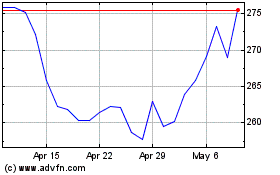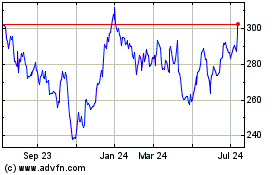Got Junk? Self-Storage Investors Hope So
December 21 2018 - 8:29AM
Dow Jones News
By Ryan Dezember
Storing people's stuff may have become too profitable a business
for its own good in recent years.
Analysts and investors are worried that the self-storage
industry has attracted so much investment during a yearslong bull
run that America's for-rent storage space may be outpacing the
volume of country's excess belongings.
Self-storage stocks have surged since the economy began bouncing
back from 2008's housing collapse. Shares of the four largest
self-storage owners have each quadrupled or better since bottoming
out in early 2009. Public Storage, CubeSmart, Life Storage Inc. and
Extra Space Storage Inc. have each outpaced the S&P 500 on a
total-return basis over the last decade, counting price changes and
dividend payments.
The 10-year total return on Extra Space, the sector's
second-largest player by locations and stock market value, is
1,182%. CubeSmart, which has a heavy presence around New York, has
returned 794%.
These real-estate investment trusts are beating the market again
this year, but concerns are mounting that billions of dollars'
worth of competing facilities under construction will challenge for
market share and prevent rents from rising like they have in recent
years.
"The fundamentals had been phenomenal for years during the
economic recovery, much better than any other sector," said Eric
Frankel, senior analyst at Green Street Advisors. "Developers and
institutional investors caught on to it so there's been a lot of
supply coming online."
Many of the new projects are being built by private developers.
So it is hard to tell exactly how many new square feet are on the
horizon.
Executives with Public Storage, the industry's
161-million-square-foot behemoth, told investors on a recent
conference call that they estimate about $4 billion worth of new
facilities have been built this year and that there will probably
be about that much added again in 2019. In the decade leading up to
2016, they said, about $1 billion worth of new construction a year
was typical.
The good news is that demand for storage doesn't seem to be
slowing. Green Street estimates that 8% of the U.S. population uses
self storage, up from 3% three decades ago, even as technology has
eliminated a lot of household clutter, like compact discs and video
tapes.
Analysts have struggled to peg storage-demand to particular
macroeconomic factors, like housing starts or retail sales. The
sector seemed to get a boost from the foreclosure crisis, which
seems reasonable given that millions of people who lost homes
probably had to move into smaller rentals or share housing.
Demand tends to be driven by death, divorce, downsizing and the
like. A cultural aversion to parting with possessions has also
helped storage owners thrive. Facility owners have shown they can
raise rents much more aggressively than in other segments of real
estate, such as apartments or offices.
"People always need some place to store their junk," said Alice
Chung, a commercial real-estate analyst at Moody's Investors
Service. "No one is going to start moving their stuff out just to
save $3 or $4 a month."
To receive our Markets newsletter every morning in your inbox,
click here.
Write to Ryan Dezember at ryan.dezember@wsj.com
(END) Dow Jones Newswires
December 21, 2018 08:14 ET (13:14 GMT)
Copyright (c) 2018 Dow Jones & Company, Inc.
Public Storage (NYSE:PSA)
Historical Stock Chart
From Mar 2024 to Apr 2024

Public Storage (NYSE:PSA)
Historical Stock Chart
From Apr 2023 to Apr 2024
